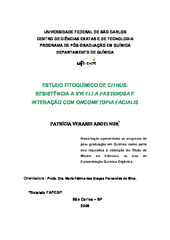Estudo fitoquímico de Citrus: resistência a Xylella fastidiosa e interação com Oncometopia facialis.
Abstract
This work describes sixteen substances isolated by C. limonia: xanthyletin, seselin,
xanthoxyletin, trans-kellactone, trans-decursidinol, junosmarin, scopoletin,
isoscopoletin, demethylsuberosin, xanthoarnol, clausarin, limonianin, 5,4 -
dihydroxy-6-(3 -methyl-2 -buthenyl)-2 ,2 -dimethylpyrano(5 ,6 -7,8)flavanone, β-
sitosterol, estigmasterol e campesterol. Three of them are especially important:
5,4 -dihydroxy-6-(3 -methyl-2 -buthenyl)-2 ,2 -dimethylpyrano(5 ,6 -7,8)flavanone
that was unknown in the literacy, trans-kellactone and trans-decursidinol that
weren t found previously in the Rutaceae family but at Apiaceae family. The
chemical constituents isolated by the upper and low parts from the grafted plant (C.
sinensis on C. limonia) and from ungrafted C. limonia were compared. It indicated
that the grafted plant has a metabolic translocation process. The Minimum
Inhibitory Concentration of many substances isolated from plants of Rutaceae
family was related. The test was against the bacteria Xylella fastidiosa that causes
Citrus Variegated Chlorosis. The successful classes the pyranocoumarins and
flavones whose MIC was 1,0 mg/mL. We have studied the plant-insect interaction
and discovered that the grafted plant (C. sinensis on C. limonia) undergoes
chemical alteration of the volatile compounds and essential oils when it is in
contact with the sharpshooter. The sharpshooters Oncometopia facialis belongs to
the Cicadellidae family and carries the Xylella fastidiosa. This chemical alteration
was greater in the volatile compounds than in the essential oils of the plants.
Different amounts of Hesperidin were found in the grafted plant when different
species of Citrus were analized: C. limonia without CVC, C. reticulata without CVC,
C. sinensis on C. limonia with and without CVC. The C. limonia presented the
lower amount of the secondary metabolic and the C. sinensis on C. limonia
presents the higher amount. The higher amounts of Hesperidin were found in sick
plants witch corresponds the metabolic alteration that occurs when the plant is
infected by the bacteria.
